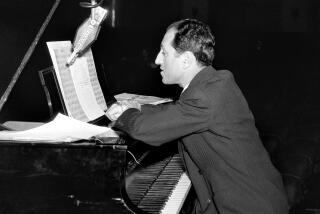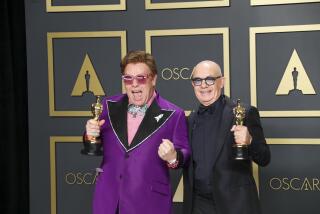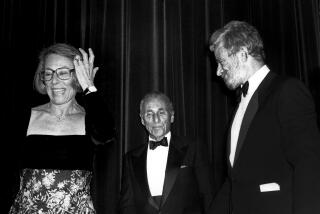For you, for me, for evermore
- Share via
INVITATIONS rained down on George Gershwin (1898-1937) throughout his short, extraordinary life. The festivities, taking off in the roaring ‘20s, didn’t slow down after the Depression pulled the plug on the Jazz Age. The entertainment industry trundled on, and there were always parties in New York and L.A. for people like him. One of the most sought-after guests, he was usually found seated at the piano in some impressive living room, playing and singing his wares as the Marx Brothers, Moss Hart, Charles Lindbergh, Lillian Hellman and Fanny Brice, among illustrious others, refilled their drinks.
The fun looked like it would never end, but then abruptly it did. While living in Beverly Hills and composing for the movies, Gershwin began suffering debilitating headaches and bouts of vertigo. Misdiagnosed, his condition grew worse, until he eventually fell into a coma. A spinal tap revealed the presence of a brain tumor, and he died after undergoing emergency surgery. He was 38. Less than two years earlier, “Porgy and Bess,” the folk opera that represented his most ambitious undertaking, had its Broadway premiere. It turned out to be the pinnacle of his career, though at the time it was as if the door to an exciting new future in musical theater had just blown open.
In “George Gershwin: His Life and Work,” Howard Pollack, a professor of music at the University of Houston, wants to widen our understanding of an artist whose glamorous existence and tragic demise make him easy to romanticize. The book, meant more for an academic than a general readership, cares less about narrative momentum than about correcting false assumptions and settling niggling disputes. The first half examines Gershwin’s personal and professional development; the second surveys his compositions. Relying on published accounts (scrupulously vetted for errors) as well as on fresh research incorporating a cache of scores discovered in a Warner Bros. warehouse in 1982, Pollack’s critical biography often reads like a lengthy reference work. But its assiduous authority is made more genial by the author’s contagious affection for his subject.
Gershwin’s prodigious legacy staggers the imagination, particularly when you consider the dazzling distractions confronting someone of his talents who had barely reached middle age. A shy and emotionally reticent man with a subtle melancholy streak and a rigorous work ethic, Gershwin felt, somewhat paradoxically, happiest in the company of others. At once modest and egomaniacal, he was the subject of countless good-natured jokes about his need for constant attention. When Gershwin once questioned whether his music would still be played in 100 years, humorist Newman Levy replied, “It certainly will be, if you are still around.”
Everybody (with the possible exception of the acutely rivalrous Kurt Weill) wanted to hang out with him. Playwright S.N. Behrman summed up what it was like to be in Gershwin’s orbit: “I felt on the instant, when he sat down to play, the newness, the humor, above all the rush of the great heady surf of vitality. The room became freshly oxygenated; everybody felt it, everybody breathed it.” Another friend recalled, “You cannot imagine what a party was like when he was expected and he did not appear.” His death, needless to say, cast a pall over his soiree set. “When George died, a great many people felt not only sad but bored,” said Kay Swift, a composer and longtime romantic friend. “People thought that they could never sense that special joy again.”
Of course, that inimitable Gershwin frisson is conveyed in the treasure trove of tunes he left behind. Pollack sees the composer as “fundamentally a man of the theater,” but it’s the music that endures, detached from the musicals that inspired it. In fact, though it’s fair to praise Gershwin for the way he furthered the theatrical integration of song and story, most of us who have come to know “The Man I Love” from, say, Sarah Vaughan’s interpretation might be disappointed to learn of its contrived setup in “Strike Up the Band,” the satiric musical comedy on which Gershwin and his brother Ira collaborated with George S. Kaufman. The standards have indeed outlasted their sources. Even heralded shows, such as “Of Thee I Sing,” another Kaufman collaboration and the first musical comedy to win a Pulitzer for drama, are rarely revived anymore. And to rescue the stage version of “Funny Face” from the Broadway morgue, Tommy Tune had to totally transform the work into “My One and Only,” the title of one of its better-known numbers.
But Pollack helpfully reminds us that there was something greater that Gershwin was after, not only in the scores he wrote but also in his more adventurous orchestral compositions, such as “An American in Paris.” What was this unifying mission of his genius? Like Walt Whitman, Gershwin set out to transform the bustle and clamor of his homeland into lyrical sound. Growing up among immigrants on the Lower East Side and Harlem, he assimilated “forgotten melodies and the craze of the moment, bits of opera, Russian folk songs, Spanish ballads [and] rag-time ditties” into a “mighty chorus” expressing “the soul of this great America of ours.” Whether composing light fare or more serious material, he was drawn to the vernacular and the freedom lying beyond the polarity of “high” and “low.”
Pollack dispatches the family background in the first chapter. Gershwin’s parents, Jews born in St. Petersburg, Russia, married in 1895, a few years after their arrival in the United States. Though we’re not given many details about domestic finances, Gershwin’s mother apparently didn’t take kindly to the rags-to-riches interpretation of her son’s life promulgated in the 1945 biopic “Rhapsody in Blue.” “There was always enough money for Georgie’s lessons,” she maintained. “Poppa had 12 restaurants.” Middle class compared to their neighbors, the Gershwins were still most at home in the working-class Yiddish-speaking enclaves of New York, with their go-getter mentality, vibrant theater and general cross-cultural fertilization.
Tracing Gershwin’s rise from high school dropout to Tin Pan Alley song plugger to Broadway bon vivant and internationally renowned composer, Pollack takes pains to dispel the popular notion of Gershwin as a naive genius. He quotes Ira: “George from the age of 13 or 14 never let up in his studies of so-called classical foundations and ... by the time he was 30 or so could be considered a musicologist (dreadful word) of the first degree besides being a composer.” Pollack extensively parses Gershwin’s influences, from his major teachers (Charles Hambitzer, Edward Kilenyi and Joseph Schillinger) to his list of famous “B’s” -- Bach, Beethoven, Brahms and Berlin -- to whom he felt indebted, and dozens of other predecessors and contemporaries who shaped his unique “fusion” of classical music, jazz and ragtime.
If mere thoroughness were a virtue, Pollack would be a saint. But biographical storytelling loses something in the quest for comprehensiveness. Gershwin, who had a scholarly strain despite his lack of formal education, might have approved of the exhaustive treatment. And he certainly would have loved the way Pollack bends over backward to protect him, shoring up his reputation as a first-rate orchestrator in the face of lingering doubts, painting him as a kind of prototypal metrosexual rather than as a bisexual (as has been occasionally whispered) and even hinting that his forgotten musicals might be stage worthy today. But it’s hard to imagine Gershwin recommending the book to his carefree friends, who surely would have preferred to top off his Champagne glass and listen to another round of “ ‘S Wonderful.” *
More to Read
Sign up for our Book Club newsletter
Get the latest news, events and more from the Los Angeles Times Book Club, and help us get L.A. reading and talking.
You may occasionally receive promotional content from the Los Angeles Times.











